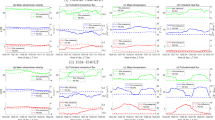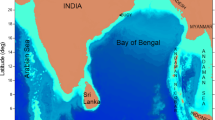Abstract
The relation between the intensity of breaking of individual wind-wave crests and parameters of wave size and wave form (e. g., height, period, steepness and skewness) is examined, and the process of change of these parameters is studied in a wind-wave tank (reference wind speed 15 m sec−1, fetch 16 m). Distributions of the wave form parameters are different for breaking and nonbreaking waves. Fully breaking waves seem to hold the relationH ∞T 2, whereH is the individual wave height andT is the period. The condition of breaking is not simply determined by the simple criterion of Stokes' limit. Wave height and steepness of a breaking wave are not always larger than those of a nonbreaking wave. This suggests the existence of an overshooting phenomenon in the breaking wave. The wave form parameters are found to change cyclically in a statistical sense during the wave propagation. The period of the cycle in the present case is estimated to be longer than four wave periods. An intermittency of wave breaking is associated with this cyclic process. Roughly speaking, two or three succeeding breaking-waves sporadically exist among a series of nonbreaking waves along the fetch.
Similar content being viewed by others
References
Benjamin, T.B. and J. E. Feir (1967): The disintegration of wave trains on deep water. J. Fluid Mech.,27, 417–430.
Donelan, M., M. S. Longuet-Higgins and J. S. Turner (1972): Periodicity in whitecaps. Nature,239, 449–451.
Koga, M. (1981): Direct production of droplets from breaking wind waves: its observation by a multi-colored overlapping exposure photographing technique. Tellus,33, 552–563.
Koga, M. (1982): Bubble entrainment in breaking wind waves. Tellus,34, 481–489.
Kondo, J., Y. Fujinawa and G. Naito (1973): High-frequency components of ocean waves and their relation to the aerodynamic roughness. J. Phys. Oceanogr.,3, 197–202.
Monahan, E. C. (1969): Fresh water whitecaps. J. Atmos. Sci.,26, 1026–1029.
Monahan, E. C. (1971): Oceanic whitecaps. J. Phys. Oceanogr.,1, 139–144.
Okuda, K. (1982a): Internal flow structure of short wind waves. Part I. On the internal vorticity structure. J. Oceanogr. Soc. Japan,38, 28–42.
Okuda, K. (1982b): Internal flow structure of short wind waves. Part II. On the streamline pattern. J. Oceanogr. Soc. Japan,38, 313–322.
Okuda, K. (1983): Internal flow structure of short wind waves. Part III On the pressure distributions. J. Oceanogr. Soc. Japan,38, 331–338.
Thorpe, S. A. and P. N. Humphries (1980): bubbles and breaking waves. Nature,283, 463–465.
Toba, Y. (1961): Drop production by bursting of air bubbles on the sea surface (III). Study by use of a wind flume. Memoirs Coll. Sci. Univ. Kyoto, Ser. A,29, 313–344.
Toba, Y. (1978): Stochastic form of the growth of wind waves in a single-parameter representation with physical implications. J. Phys. Oceanogr.,8, 494–507.
Toba, Y. and H. Kunishi (1970): Breaking of wind waves and the sea surface wind stress. J. Oceanogr. Soc. Japan,26, 71–80.
Toba, Y., M. Tokuda, K. Okuda and S. Kawai (1975): Forced convection accompanying wind waves. J. Oceanogr. Soc. Japan,31, 192–198.
Tokuda, M. and Y. Toba (1981): Statistical characteristics of individual waves in laboratory wind waves. I. Individual wave spectra and similarity structure. J. Oceanogr. Soc. Japan,37, 243–258.
Author information
Authors and Affiliations
Rights and permissions
About this article
Cite this article
Koga, M. Characteristics of a breaking wind-wave field in the light of the individual wind-wave concept. Journal of the Oceanographical Society of Japan 40, 105–114 (1984). https://doi.org/10.1007/BF02302491
Received:
Revised:
Accepted:
Issue Date:
DOI: https://doi.org/10.1007/BF02302491




